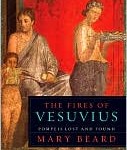By Mary Beard
It couldn’t have been an easy way to die, sucking in billows of scalding ash until it filled the lungs, surely as it would fill every nook and cranny of Pompeii. Or horribly overrun by the pyroclastic surge, a combination of gases and molten rock traveling at huge speed. Really, those who stayed in town — what were they thinking? When Vesuvius blew its lid in August of the year 79, there had to have been forewarning: rumbles, tremors, smoke signals. The stragglers played it as a bluff, and got burned.
And it wasn’t as if Pompeians hadn’t experienced the Earth’s fury in the recent past, as Mary Beard, professor of classics at the University of Cambridge, writes in this wry, recondite and colorful story of what is known and what is conjectured about life in Pompeii before the fall. An earthquake had shaken the town to its foundation stones in A.D. 62. Pompeii was still picking up the pieces of that disaster when Vesuvius lit up.
What Vesuvius preserved was a town in flight, which is certainly magical in that sense of immediate contact we have with the victims, but that is not the town Beard is after. She wants the town as it went about its daily business – “the colour, clutter and bric-a-brac of urban life that tends to be forgotten when we stare at the now bare ruins.”
Easier said than done, as Beard freely admits. “Disrupted and disturbed, evacuated and pillaged, it bears the marks (and the scars) of all kinds of different histories.” A challenging and intriguing place, but one that is more likely to give up a vivid detail – a telling piece of graffiti, the remains in a cafe, a gladiator’s room – whereas the big picture stays back in the murk.
Even so, like a canny cook making a banquet from scant means, Beard creates a living Pompeii for the reader from the hard evidence at her disposal. Though she is a skeptic, never pretending to ingredients she doesn’t have in her larder – “rather weak confirmation in my view,” “despite some confident assertions to the contrary” – she knows how to take the gaudy razzmatazz of a building’s facade or the messy amalgam of workaday shops jumbled with mansions, and make them do a little singing for the reader. She is also willing, occasionally, to shape some poetic ambience: by night, the homes would be “blanketed in darkness – brightened only by moon and stars, a couple of braziers … and the rather feeble twinkling of any number of little lamps.”
Background is provided: By the time Pompeii went under its burden of volcanic debris, it was an old place and hardly a backwater. Native Oscans rubbed shoulders with Greek settlers in the centuries B.C.; Italian heartland tribes made grim visits, but the early years are still a matter of debate – might the Etruscans have launched the town? That the Romans came to conquer is not an issue of contention. The Roman influence, in politics and culture and urban features, is draped all over this story.
But Beard primarily works on a more intimate scale. What does all the archaeological work tell us about, for instance, street life? From materials at hand – friezes, documents, election notices and wall paintings – and by extension from the ways things were conducted in other parts of the empire, she can fashion a look at a day in the forum, with its beggars, hucksters, school kids, fast food vendors, folks shopping for shoes and what filled the road other than carts and pedestrians (a lot of filth that stings the nostrils even at this distance).
Beard also screws the focus down to particular institutions: gladiators (“the best insight from anywhere in the Roman world … into the lives (and deaths) of the gladiators”); why cafe society was not for the upper crust, nor were the brothels (the rich had kitchens and slaves, respectively); the deities, whose images were everywhere: “standardized, funny, expensive or exotic, they were … ways of imaging the divine inhabitants of the world in material form.”
This is a lively piece of work, with an easy familiarity and obvious pleasure in the subject, wearing its knowledge lightly, and not above some mischievous poking at Pompeii’s many controversies. Beard, wisely, keeps an eye skinned for fun, such as relating the sensible advice of a Roman doctor regarding public baths and fresh wounds: “It normally leads to gangrene.”
(from The San Francisco Chronicle)
